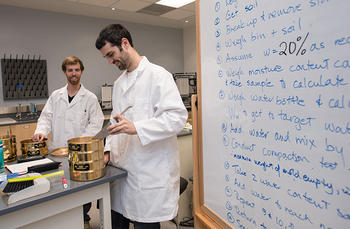“One of our goals is to be able to predict future flood hazards in real time to minimize its impacts to people and infrastructure.”
— Celso Ferreira, associate professor and principal investigator of Flood Hazards Research Lab
Our research labs focus on flood hazard mitigation, geo-transportation, geo-environmental engineering, and advanced infrastructure monitoring. Students get experience in such areas as hydraulics, soils, and environmental engineering.
Our Research Labs
Flood Hazards Research Lab
Located at the Potomac Science Center in the tidal waters of Belmont Bay, the Flood Hazards Research Lab is the home base for our researchers exploring the power of natural wetlands and their vegetation to dissipate the energy of storm surge waves to protect coastal communities from sea-level rise during intense hurricanes. They use field data and computational models to focus on sustainable solutions to coastal floods.
SGI Research Group
The Sustainable Geo-transportation/Geoenvironmental Infrastructure (SGI) Research Group at the Krasnow Institute for Advanced Studies is equipped to conduct research related to evaluating engineering properties of recycled materials, aggregates, and soils, as well as geo-environmental assessments of wastewater and leachates, and geosynthetics used in landfill liner and cover systems. The laboratory contains a large-scale model experiment set-up that allows the SGI team to simulate roadways and earth-retaining structures constructed with recycled materials and geosynthetics to replicate field conditions as closely as possible.
AIM Lab

The Advanced Infrastructure Monitoring (AIM) Lab, located in the Research Hall Building, was designed to enable both high-performance computational work and advanced field inspection initiatives. The equipment includes high-performance computing systems, scientific imaging and image-calibration tools, 3D imaging equipment, virtual reality hardware, 3D printers, inspection robots (mostly UAVs), bench-top design and repair workspaces, field inspection equipment, and a variety of sensors, micro-computers, and other tools.
John Toups Instructional Laboratory
The John Toups Instructional Laboratory for Civil, Environmental, and Infrastructure Engineering, located in the Nguyen Engineering Building, gives undergraduate and graduate students hands-on experience in hydraulics, soils, and environmental engineering. Students test, build, experiment, innovate, and work in teams. The lab is named after the late John Toups, an entrepreneur, civil engineer, and Northern Virginia businessman.
